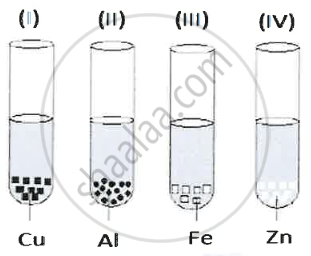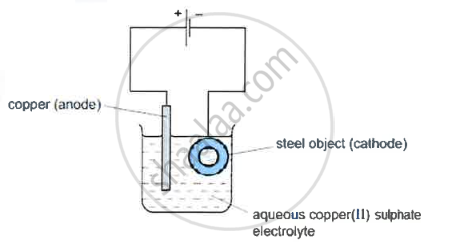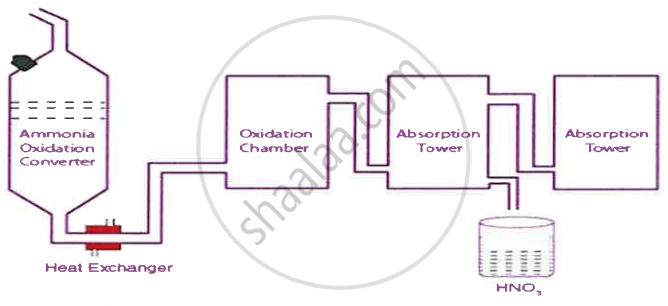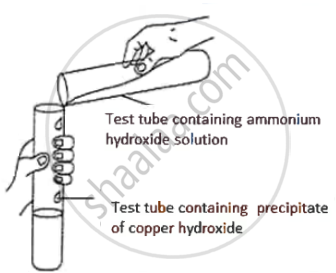(English Medium)
Academic Year: 2024-2025
Date: एप्रिल 2025
Advertisements
- Answers to this Paper must be written on the paper provided separately.
- You will not be allowed to write during first 15 minutes.
- This time is to be spent in reading the question paper.
- The time given at the head of this Paper is the time allowed for writing the answers.
- Section A is compulsory. Attempt any four questions from Section B.
- The intended marks for questions or parts of questions are given in brackets [ ].
An aqueous solution of copper sulphate turns colourless on electrolysis.
Which of the following could be the electrodes?
P. anode: copper; cathode: copper
Q. anode: platinum; cathode: copper
R. anode: copper; cathode: platinum
Only P
Only Q
Only R
Both Q and R
Chapter: [0.06] Electrolysis
A compound P is heated in a test tube with sodium hydroxide solution. A red litmus paper held at the mouth of the test tube turns blue.
Which of the following could compound P be?
Zinc sulphate
Copper sulphate
Ferrous sulphate
Ammonium sulphate
Chapter: [0.03] Study of Acids, Bases and Salts
Which of the following would weigh the least?
(Atomic masses C = 12, 0 = 16, Na = 23)
2 gram atoms of oxygen
One mole of sodium
22.4 litres of carbon dioxide at STP
6.023 × 1022 atoms of carbon
Chapter: [0.01] Periodic Table, Periodic Properties and Variations of Properties
The equation below shows the reaction between element ‘X’ and dilute sulphuric acid.
\[\ce{X(s) + H2SO4 (aq.) -> XSO4 (aq.) + H2(g)}\]
Which particles are responsible for conducting electricity in dilute sulfuric acid and compound XSO4?
Electrons
Only positive ions
Only negative ions
Both positive and negative ions
Chapter: [0.1] Practical Work
Assertion (A): Dry hydrogen chloride gas is collected by the upward displacement of air.
Reason (R): Hydrogen chloride gas is lighter than air.
Both A and R are true and R is the correct explanation of A
Both A and R are true but R is not the correct explanation of A
A is true but R is false
A is false but R is true
Chapter: [0.081] Hydrogen Chloride
The structures of four hydrocarbons are shown below:
| \[\begin{array}{cc} \phantom{.....}\ce{CH3}\\ \phantom{...}|\\ \ce{H3C - C - H}\\ \phantom{...}|\\ \phantom{.....}\ce{CH3} \end{array}\] |
\[\begin{array}{cc} \ce{CH3}\phantom{.....}\\ |\phantom{.......}\\ \ce{C = CH2}\\ |\phantom{.......}\\ \ce{CH3}\phantom{....} \end{array}\] |
\[\begin{array}{cc} \ce{H}\phantom{.....}\\ |\phantom{.....}\\ \ce{H3C - C - C - CH2}\\ |\phantom{....}|\\ \ce{H\phantom{...}H} \end{array}\] |
\[\begin{array}{cc} \phantom{...}\ce{CH3}\\ |\\ \ce{H3C - C = CH2} \end{array}\] |
How many isomers of butene are there?
1
2
3
4
Chapter: [0.09] Organic Chemistry
Element ‘P' has electronic configuration 2,8,8,1. The number of chlorine atoms present in the chloride of ‘P’ is ______.
2
1
3
4
Chapter: [0.01] Periodic Table, Periodic Properties and Variations of Properties
1H2 is an isotope of hydrogen. In the modern Periodic Table it will ______.
be placed before hydrogen
be placed after hydrogen
be placed at the same position as hydrogen
not have any position in the Periodic Table
Chapter: [0.01] Periodic Table, Periodic Properties and Variations of Properties
A nitrate, which forms a precipitate with ammonium hydroxide and is also soluble in excess of ______.
ferrous nitrate
ferric nitrate
lead nitrate
copper nitrate
Chapter: [0.1] Practical Work
Which of the following electronic configuration represents the most electropositive element?
2,1
2, 8, 1
2, 2
2, 8, 2
Chapter:
Assertion (A): Alkali metals do not form dipositive ions.
Reason (R): After loss of one electron alkali metals achieve a stable electronic configuration of noble gases.
Both A and R are true and R is the correct explanation of A
Both A and are true but R is not the correct explanation of A
A is true but R is false
A is false but R is true
Chapter: [0.01] Periodic Table, Periodic Properties and Variations of Properties
The ratio between the volumes occupied by 4.4 grams of carbon dioxide and 2 grams of hydrogen gas is ______.
22:1
1:2.2
1:10
10:1
Chapter: [0.081] Hydrogen Chloride
Aqueous lead (II) nitrate can be distinguished from aqueous zinc nitrate by adding any of the following solutions in excess, except:
aqueous potassium chloride aqueous sodium sulphate dilute sulphuric acid sodium hydroxide solution
aqueous sodium sulphate
dilute sulphuric acid
sodium hydroxide solution
Chapter: [0.04] Analytical Chemistry
Which of the following about oxides is correct?
A basic oxide is an oxide of a non-metal
Acidic oxides contain ionic bonds
Amphoteric oxides contain a metal
Basic oxides are always gases
Chapter: [0.04] Analytical Chemistry
A student takes Cu, Al, Fe and Zn strips, separately in four test tubes labeled as I, II, III and IV respectively. He adds 10 ml of freshly prepared ferrous sulphate solution to each test tube and observes the colour of the metal residue in each case.

He would observe a black residue in the test tubes:
(I) and (II)
(I) and (III)
(II) and (III)
(II) and (IV)
Chapter: [0.084] Sulphuric Acid
Electroplating steel objects with silver involves a three-step process.
Step 1: A coating of copper is applied to the object.
Step 2: A coating of nickel is applied to the object.
Step 3: The coating of silver is applied to the object.
-
- A diagram of the apparatus used for step 1 is shown

- The chemical process taking place on the surface of the object is \[\ce{Cu^2+(aq) + 2e- ->Cu(s)}\]
What is the observation seen on the surface of the object? - Explain why the concentration of copper ions in the electrolyte remains constant throughout step 1.
- The chemical process taking place on the surface of the object is \[\ce{Cu^2+(aq) + 2e- ->Cu(s)}\]
- A diagram of the apparatus used for step 1 is shown
- Give two changes which would be needed in order to coat nickel on to the object in step 2.
- Write down the reaction taking place at the positive electrode during step 3.
Chapter: [0.06] Electrolysis
Match the following Column A with Column B.
| Column A | Column B | ||
| (a) | Aluminium | 1. | Covalent compound |
| (b) | Sulphuric acid | 2. | Carbonate ore |
| (c) | Calcination | 3. | Hall Heroult’s process |
| (d) | Calcium Chloride | 4. | Contact Process |
| (e) | Carbon tetrachloride | 5. | Electrovalent compound |
Chapter: [0.07] Metallurgy
If an element has one electron in the outermost shell, then it is likely to have the ______ atomic size amongst all the elements in the same period.
smallest
largest
Chapter: [0.01] Periodic Table, Periodic Properties and Variations of Properties
______ does not form an acid salt.
Sulphuric acid
Hydrochloric acid
Chapter: [0.081] Hydrogen Chloride
A ______ coloured precipitate is formed when ammonium hydroxide is added to a solution of ferrous chloride.
Reddish brown
Dirty green
Chapter: [0.04] Analytical Chemistry
Alkynes undergo ______ reactions.
Addition
Substitution
Chapter: [0.09] Organic Chemistry
An ______ solution will turn methyl orange solution pink or red.
Alkaline
Acidic
Chapter: [0.03] Study of Acids, Bases and Salts
Identify the following:
A bond formed between two atoms by sharing of a pair of electrons, with both electrons being provided by the same atom.
Chapter: [0.02] Chemical Bonding
Identify the following:
A salt formed by the complete neutralization of an acid by a base.
Chapter: [0.03] Study of Acids, Bases and Salts
Identify the following:
A reaction in which the hydrogen of an alkane is replaced by a halogen.
Chapter: [0.01] Periodic Table, Periodic Properties and Variations of Properties
Identify the following:
The energy required to remove an electron from a neutral gaseous atom.
Chapter: [0.01] Periodic Table, Periodic Properties and Variations of Properties
Identify the following:
A homogenous mixture of two or more metals or a metal and a non-metal in a definite proportion in their molten state.
Chapter: [0.07] Metallurgy
Draw the structural diagram for the following compound.
propanoic acid
Chapter: [0.09] Organic Chemistry
Advertisements
Draw the structural diagram for the following compound.
pentan-2-ol
Chapter:
Draw the structural diagram for the following compound.
2,2 dibromo butane
Chapter: [0.09] Organic Chemistry
Give the IUPAC name of the following organic compound:
\[\begin{array}{cc}
\phantom{..}\ce{H\phantom{...}H\phantom{...}OH}\\
|\phantom{....}|\phantom{....}|\\
\ce{H - C - C - C - H}\\
|\phantom{....}|\phantom{....}|\\
\ce{H\phantom{...}H\phantom{...}H}
\end{array}\]
Chapter:
Give the IUPAC name of the following organic compound:
\[\begin{array}{cc}
\ce{H\phantom{...}H\phantom{...}H\phantom{...}H\phantom{...}H}\\
|\phantom{....}|\phantom{....}|\phantom{....}|\phantom{....}|\\
\ce{H - C = C - C - C - C - H}\\
\phantom{.........}|\phantom{....}|\phantom{....}|\\
\phantom{.........}\ce{H\phantom{...}H\phantom{...}H}
\end{array}\]
Chapter:
Identify the reactant and write the balanced equation for the following:
Nitric acid reacts with compound Q to give a salt Ca(NO3)2, water and carbon dioxide.
Chapter: [0.083] Nitric Acid
What property of Sulphuric acid is exhibited in the following case?
In the preparation of HCI gas when it reacts with Sodium chloride.
Chapter: [0.084] Sulphuric Acid
What property of Sulphuric acid is exhibited in the following case?
When concentrated Sulphuric acid reacts with Copper to produce Sulphur dioxide gas.
Chapter: [0.084] Sulphuric Acid
The electron affinity of an element X is greater than that of element Y.
How is the oxidising power of X likely to compare with that of Y?
Chapter: [0.01] Periodic Table, Periodic Properties and Variations of Properties
The electron affinity of an element X is greater than that of element Y.
How is the electronegativity of X likely to compare with that of Y?
Chapter: [0.01] Periodic Table, Periodic Properties and Variations of Properties
The electron affinity of an element X is greater than that of element Y.
State whether X is likely to be placed to the left or to the right of Y in the periodic table.
Chapter: [0.01] Periodic Table, Periodic Properties and Variations of Properties
You are provided with the list of chemicals mentioned below in the box:
| Sodium hydroxide solution, copper carbonate, zinc, hydrochloric acid, copper, dilute sulphuric acid, chlorine, iron |
Using suitable chemicals from the list given, write a balanced chemical equation for the preparation of the salt mentioned below:
Copper sulphate
Chapter: [0.03] Study of Acids, Bases and Salts
You are provided with the list of chemicals mentioned below in the box:
| Sodium hydroxide solution, copper carbonate, zinc, hydrochloric acid, copper, dilute sulphuric acid, chlorine, iron |
Using suitable chemicals from the list given, write a balanced chemical equation for the preparation of the salt mentioned below:
Sodium zincate
Chapter: [0.03] Study of Acids, Bases and Salts
You are provided with the list of chemicals mentioned below in the box:
| Sodium hydroxide solution, copper carbonate, zinc, hydrochloric acid, copper, dilute sulphuric acid, chlorine, iron |
Using suitable chemicals from the list given, write a balanced chemical equation for the preparation of the salt mentioned below:
Ferric chloride
Chapter: [0.03] Study of Acids, Bases and Salts
The following question relate to the extraction of aluminium by electrolysis.
Name the other aluminium containing compound added to alumina and state the significance.
Chapter: [0.07] Metallurgy
The following question relate to the extraction of aluminium by electrolysis.
Give the equation for the reaction that takes place at the cathode
Chapter: [0.07] Metallurgy
Pratik heated 11.2 grams of element ‘M’ (atomic weight 56) with 4.8 grams of element 'N' (atomic weight 16) to form a compound. Find the empirical formula of the compound obtained by Pratik.
Chapter: [0.05] Mole Concept and Stoichiometry
Write balanced chemical equations for Action of warm water on AIN.
Chapter: [0.08199999999999999] Ammonia [0.1] Practical Work
Give a balanced equation for the following:
Oxidation of carbon with conc. Nitric acid.
Chapter: [0.083] Nitric Acid
Give a balanced equation for the following:
Laboratory preparation of ethanol by using chloroethane and aqueous sodium hydroxide.
Chapter: [0.09] Organic Chemistry
The diagram given below is a representation of the Industrial preparation of Nitric acid by Ostwald’s process. With respect to the process answer the following questions:

- Write the temperature and the catalyst required during the catalytic oxidation of ammonia.
- Give balanced chemical equation for the reaction occurring duringthe conversion of nitrogen dioxide to nitric acid.
Chapter: [0.083] Nitric Acid
Ranjana wants to prove that ammonia is a reducing agent. To demonstrate this, she passes ammonia gas over heated copper oxide. What will she observe?
Chapter: [0.08199999999999999] Ammonia
Ranjana wants to prove that ammonia is a reducing agent. To demonstrate this, she passes ammonia gas over heated copper oxide.
Write a balanced chemical equation for the Black copper oxide changes to a reddish brown/pink copper reaction.
Chapter: [0.08199999999999999] Ammonia
Name the alloy which is made up of Copper, Zinc and Tin.
Chapter: [0.07] Metallurgy
Advertisements
Name an alloy of lead and tin.
Chapter: [0.07] Metallurgy
| Abhishek was given a salt 'X' which was white in colour for analysis. On strong heating, it produced a yellow residue, a colourless gas and also a reddish-brown gas. The solution of the salt 'X', when tested with an excess of ammonium hydroxide, produced a chalky white insoluble precipitate. |
- Name the coloured gas that evolved when Abhishek heated the salt strongly.
- Which cation was present in the sample given to Abhishek?
- Identify the salt given to Abhishek for analysis.
Chapter: [0.04] Analytical Chemistry
Given below in column A is a schematic diagram of the electrolytic reduction of alumina. Identify the parts labelled as A, B and C with the correct options from the Column B.
| column A | column B | |
 |
1. | Platinum |
| 2. | Anode | |
| 3. | Cathode | |
| 4. | Electrolyte mixture | |
| 5. | Bauxite |
Chapter: [0.07] Metallurgy
Element 'X' forms an oxide with the formula X2O3 which is a solid with high melting point. ‘X’ would most likely be placed in the group of the Periodic Table as:
Na
Mg
Al
Si
Chapter: [0.01] Periodic Table, Periodic Properties and Variations of Properties
Justify. Element 'X' forms an oxide with the formula X2O3 which is a solid with a high melting point. ‘X’ would most likely be placed in the group of the Periodic Table as Al.
Chapter: [0.01] Periodic Table, Periodic Properties and Variations of Properties
A student was asked to perform an experiment in the laboratory based on the instructions given:
Observe picture given below and state one observation for the experiment you would notice on mixing the given solution.

Chapter: [0.04] Analytical Chemistry
A student was asked to perform an experiment in the laboratory based on the instructions given:
Observe the picture given below and state one observation for the experiment you would notice on mixing the given solution.

Chapter: [0.04] Analytical Chemistry
Copper sulphate solution is electrolysed using copper electrodes.
Which electrode [cathode or anode] is the oxidizing electrode? Why?
Chapter: [0.06] Electrolysis
Copper sulphate solution is electrolysed using copper electrodes.
Write the equation for the reaction occurring at the Anode electrode.
Chapter: [0.06] Electrolysis
X [2, 8, 7] and Y [2, 8, 2] are two elements. Using this information, complete the following:
______ is the metallic element.
Chapter: [0.07] Metallurgy
X [2, 8, 7] and Y [2, 8, 2] are two elements. Using this information, complete the following:
Metal atoms tend to have a maximum of ______ electrons in the outermost shell.
Chapter: [0.07] Metallurgy
X [2, 8, 7] and Y [2, 8, 2] are two elements. Using this information, complete the following:
______ is the reducing agent.
Chapter: [0.07] Metallurgy
One variety of household fuel is a mixture of propane (60%) and butane (40%). If 20 litres of this mixture is burnt, find the total volume of carbon dioxide added to the atmosphere. The combination reactions can be represented as:
\[\ce{C3H8 + 5O2 -> 3CO2 + 4H2O}\]
\[\ce{2C4H10 +13O2 -> 8CO2 + 10H2O}\]
Chapter: [0.09] Organic Chemistry
Rohit has solution X, Y and Z that has pH 2, 7 and 13 respectively.
Which solution will liberate sulphur dioxide gas when heated with sodium sulphite?
Chapter: [0.1] Practical Work
Rohit has solution X, Y and Z that has pH 2, 7 and 13 respectively.
Which solution will liberate ammonia gas when reacted with ammonium chloride?
Chapter: [0.03] Study of Acids, Bases and Salts [0.1] Practical Work
Rohit has solution X, Y and Z that has pH 2, 7 and 13 respectively.
Which solution will not have any effect on litmus paper?
Chapter: [0.03] Study of Acids, Bases and Salts
8.2 grams of calcium nitrate is decomposed by heating according to the equation
\[\ce{2Ca(NO3)2 -> 2CaO + 4NO2 + O2}\]
Calculate the following:
Volume of nitrogen dioxide obtained at STP
[Atomic weights: Ca − 40, N − 14, 0 − 16]
Chapter: [0.1] Practical Work
8.2 grams of calcium nitrate is decomposed by heating according to the equation
\[\ce{2Ca(NO3)2 -> 2CaO + 4NO2 + O2}\]
Calculate the following:
Mass of CaO formed
[Atomic weights: Ca - 40 , N - 14, 0 - 16]
Chapter: [0.1] Practical Work
State the reasons if:
Zinc and aluminium can be distinguished by heating the metal powder with a concentrated sodium hydroxide solution.
Chapter: [0.07] Metallurgy
State the giving reasons if:
Calcium nitrate and lead nitrate can be distinguished by adding ammonium hydroxide solution to the salt solution.
Chapter: [0.1] Practical Work
Draw an electron dot diagram for the formation of the following. State the type of bonding present in them.
Ammonium ion
Chapter: [0.02] Chemical Bonding
Write the equation of the following laboratory preparations:
Ethyne from calcium carbide
Chapter: [0.09] Organic Chemistry
Give a balanced equation for the following:
Conversion of acetic acid to ethyl acetate.
Chapter: [0.09] Organic Chemistry
Give a balanced chemical equation for Laboratory preparation of Nitric acid.
Chapter: [0.083] Nitric Acid
The structures of six organic compounds are shown:
|
A \[\begin{array}{cc} |
B \[\begin{array}{cc} |
C \[\begin{array}{cc} |
|
D \[\begin{array}{cc} |
E \[\begin{array}{cc} |
F \[\begin{array}{cc} |
- Identify two of the compounds that are members of the same homologous series but are not isomers.
- Which two compounds are isomers of each other?
- F can be prepared from D. Give a chemical equation for the reaction.
Chapter: [0.09] Organic Chemistry
Other Solutions
Submit Question Paper
Help us maintain new question papers on Shaalaa.com, so we can continue to help studentsonly jpg, png and pdf files
CISCE previous year question papers ICSE Class 10 Chemistry with solutions 2024 - 2025
Previous year Question paper for CISCE ICSE Class 10 -2025 is solved by experts. Solved question papers gives you the chance to check yourself after your mock test.
By referring the question paper Solutions for Chemistry, you can scale your preparation level and work on your weak areas. It will also help the candidates in developing the time-management skills. Practice makes perfect, and there is no better way to practice than to attempt previous year question paper solutions of CISCE ICSE Class 10 .
How CISCE ICSE Class 10 Question Paper solutions Help Students ?
• Question paper solutions for Chemistry will helps students to prepare for exam.
• Question paper with answer will boost students confidence in exam time and also give you an idea About the important questions and topics to be prepared for the board exam.
• For finding solution of question papers no need to refer so multiple sources like textbook or guides.
